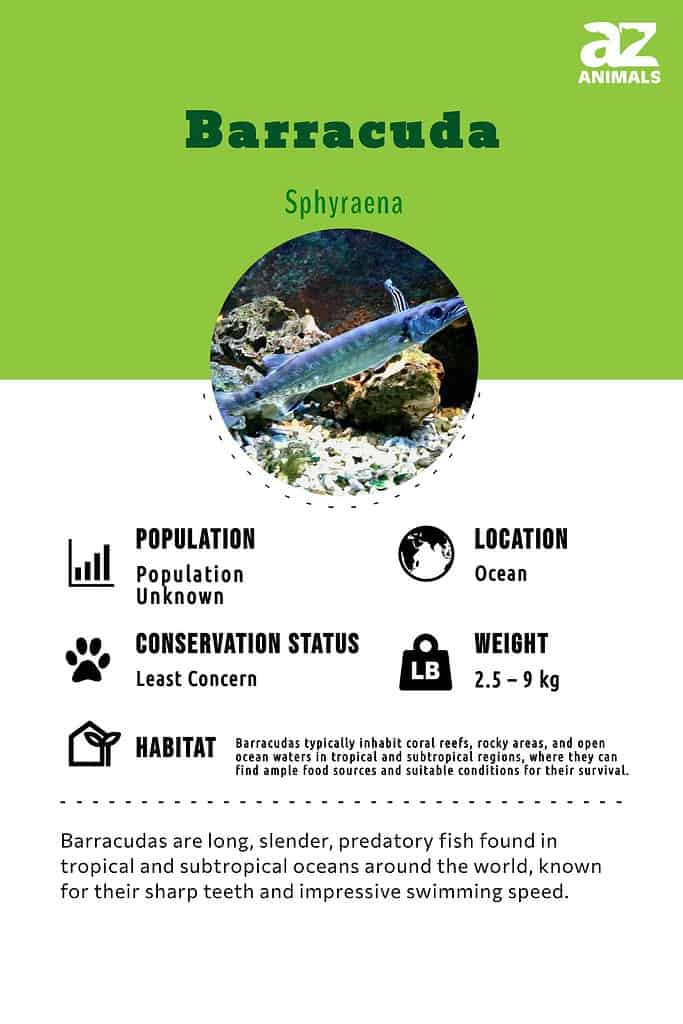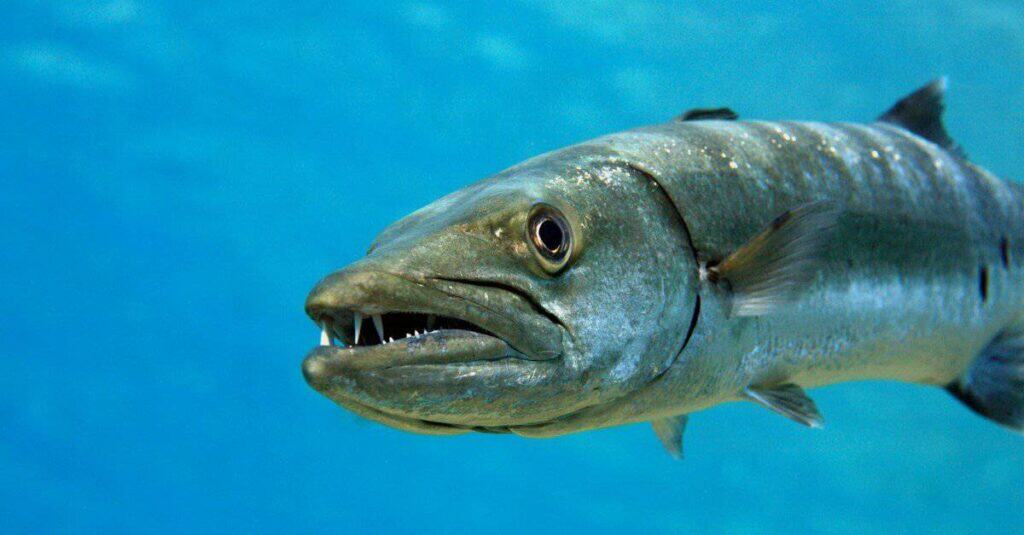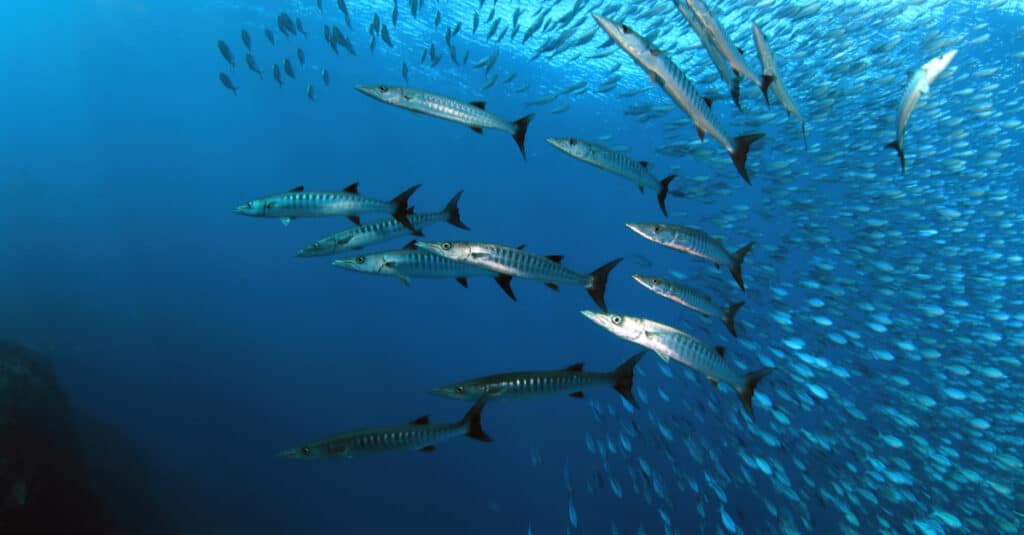Can grow to nearly 2 meters long!
Advertisement
Barracuda Scientific Classification
- Kingdom
- Animalia
- Phylum
- Chordata
- Class
- Actinopterygii
- Order
- Perciformes
- Family
- Sphyraenidae
- Genus
- Sphyraena
- Scientific Name
- Sphyraena
Read our Complete Guide to Classification of Animals.
Barracuda Conservation Status
Barracuda Facts
- Main Prey
- Fish, Plankton, Invertebrates
- Distinctive Feature
- Large body size and powerful jaws
- Optimum pH Level
- 5 - 7
- Habitat
- Coastal lagoons and coral reefs
- Predators
- Sharks, Humans, Killer Whales
- Diet
- Carnivore
- Favorite Food
- Fish
- Common Name
- Barracuda
- Average Clutch Size
- 1000
- Slogan
- Can grow to nearly 2 meters long!
View all of the Barracuda images!

Barracuda fish capture their prey in the ocean with quick bursts of speed as fast as 27 mph.
Barracuda fish are carnivores that hunt for prey at night. These saltwater fish live in warm water – specifically tropical and subtropical oceans.
A large, lower jaw and sharp teeth give barracudas a fierce appearance. Some barracudas live in groups called schools while others are solitary. The average lifespan of a barracuda fish is 14 years.
Interesting Barracuda Facts

Barracuda swimming in the ocean. Barracudas are adept hunters with few predators because of their speed and size.
©aquapix/Shutterstock.com
- The biggest barracuda on record weighed in at 102 pounds, 8 ounces, and was seven feet long!
- Normally, females grow to be bigger than males of the species.
- Barracudas, sometimes called Tigers of the Sea, has dozens of sharp teeth they use to capture and eat their prey.
- Some of its teeth are angled backward inside its mouth to keep small fish from slipping out.
- The largest species of barracuda can grow to be 10 feet long!
Scientific Name

Wahoo fish and barracuda look very similar
©orifec_a31/Shutterstock.com
Sphyraena is the scientific name of a barracuda also known as simply a ‘cuda.’ It belongs to the Sphyraenidae family and the class of Actinopterygii. Sphyraena is a Latin word that means pike-like, which refers to the thin, narrow body of this fish.
There are 26 species of barracuda ranging in color and size. Some members of this group include the Great barracuda, Blacktail barracuda, Yellowtail barracuda, and the Pickhandle barracuda.
Here are a few different types of barracuda:
- Great barracuda (Sphyraena sphyraena)
- Yellowtail barracuda
- Obtuse barracuda
- Australian barracuda
- Pickhandle barracuda
- Guachanche barracuda
- Sphyraena japonica
- Northern sennet (Sphyraena arabia)
Evolution and Origins

Catching barracuda fish, a fisherman in sport fishing boat holding big game fishing rod and reel 3d render
©iStock.com/bbevren
Predatory fish called barracudas live in tropical and subtropical oceans all around the world. Around 70 million years ago, during the Late Cretaceous period, the family Sphyraenidae first appeared. This marks the beginning of the evolutionary history and origins of the barracuda.
Barracudas are a diverse group of animals that have developed over time to suit their unique habitats and prey items.
They have evolved a number of characteristics that make them successful hunters in marine ecology, including a streamlined body, pointed teeth, and superb swimming skills.
Appearance
These fish have long, thin bodies that are usually silver in color. Of course, there are some small differences in appearance depending on the type of barracuda you’re studying. A great barracuda is a silver with spots while a Pickhandle barracuda has a line of dark bars running across its silver scales. The coloration of some smaller barracudas protects them from predators as they blend in with the rocks and sand on the ocean floor.
The fish’s thin body allows it to move through the water quickly as well as swim in and out of narrow spaces in a coral reef. The average length of the fish is about two feet. Think of a wooden ruler you may use in school. Line up two of those rulers end to end and you’re looking at the length of a two-foot barracuda.
The weight range of the average barracuda is 10 to 12 pounds, but some species weigh more than others. For reference, a 12-pound fish weighs about the same as a big can of paint you’d see on the shelf in a home improvement store.
The biggest barracuda on record was caught by Dr. Cyril Fabre in Gabon in 2002. It weighed 102 pounds, 8 ounces, and was 7 feet long! That’s about the same weight as the average 13-year-old human boy.
One of the most notable things about this fish is its pointy lower jaw that sticks out as it swims along. It usually has its mouth partially open revealing dozens of tiny, sharp teeth. Some of these teeth are angled in a forward direction while others tilt backward inside its mouth. The backward teeth keep small swimming creatures such as anchovies from slipping out of the fish’s mouth. Their teeth are designed to tear and chew their prey.

Behavior
Though most adult barracudas live alone, much younger fish live in groups called schools. Schools can sometimes include hundreds of young fish.
Living in such a large group provides protection against predators such as killer whales, dolphins, sharks, or even larger barracudas. A school of young fish moves through the ocean in the shape of a tornado to further confuse predators. Now, that’s cooperation!
These fish are aggressive and can be competitive with other sea creatures when hunting for prey. If a dolphin is going after a herring or mullet, a barracuda may try to get the prey for itself. It doesn’t shy away from a fight.
They are also scavengers. This means they will eat any parts of prey left behind by another sea creature.
These fish hunt with their eyes more than any of their other senses. They swim around looking for shiny objects moving in their line of sight. When they think they’ve spotted a shiny fish, they speed up and attack. A swimmer or surfer who’s wearing a silver watch or a piece of jewelry may be bitten by a barracuda who has mistaken the shiny jewelry for food. Normally, these fish want to stay clear of humans.
Habitat
These fish live throughout the world in tropical and subtropical oceans, including the western and eastern Atlantic Ocean, the Gulf of Mexico, the Caribbean Sea, and the Red Sea.
They also live around coral reefs, in seagrasses, and in mangroves that are near shore. Their narrow body structure allows them to dart in and out of the holes and crevices in a coral reef. Most of their prey live in and around coral reefs as well.
Smaller fish also use the coral reef as protection from predators. But, when they venture out into the open waters of the ocean, they usually swim near the surface and then dive deeper if they spot a predator in the area.
Diet
What do these fish eat? They are carnivores eating groupers, grunts, small tuna, anchovies, herring, and more. A barracuda has such powerful jaws that it simply bites a herring or grunt in half.
The larger the species, the larger its prey will be. A great barracuda may go after a large snapper while a yellowtail barracuda preys on small herring.
These fish hunt at night, eating small prey or tearing into larger swimming creatures with their razor-sharp teeth.
Predators and Threats
Predators of these fish include killer whales, sharks, dolphins, and the Goliath grouper. All of these predators can match them in speed and strength.
Larger species like the great barracuda have fewer predators than the smaller types such as yellowtail and blacktail barracudas.
Barracudas are usually found in saltwater searching for schools of plankton-feeding fish. Plankton can be difficult to spot that’s why barracudas heavily rely on their eyesight when they go out hunting. When hunting, they tend to notice anything that has an intriguing color, reflection, or shape.
Humans are also a threat to these fish. Humans will hunt barracudas as food and can also accidentally let them become tangled in nets meant for other sea creatures. When they get tangled in a net, they may drown or be thrown out.
These fish also deal with some types of parasites as well as different types of pollution in the ocean. Like other sea creatures, they are also put at risk by weather events such as hurricanes. But, despite all of these challenges, they are not at risk for extinction. The official conservation status is Least Concern.
Reproduction, Babies, and Lifespan
It’s believed that these fish spawn, or release their eggs, between the months of April and October each year. Marine biologists are not sure about the exact time period.
Females release eggs and males release sperm into a shallow area of water. A female can release 5,000 to as many as 30,000 eggs! These eggs are very small and many are likely to be eaten by sea creatures swimming by. A female releases thousands of eggs making it more likely that at least some will be fertilized and grow into adults.
After the eggs are fertilized by the sperm, they float in the open water until they hatch. Once the eggs hatch, the barracuda larvae look for vegetation to eat. The shallow water provides hiding places and protection against predators. When the larvae grow to be juveniles, they move further out into the ocean to find a home in a coral reef.
Barracuda have an average lifespan of 14 years since they have a limited number of predators and aren’t especially vulnerable to illness or disease. Their ability to dive deep into the ocean and swim at a fast rate can also protect them from humans hunting for barracudas to sell as food.
Population
Barracudas live in tropical and subtropical bodies of water all over the world. They are categorized as Least Concern by the International Union for the Conservation of Nature (IUCN) and their population is holding steady. There are laws that specify how many and what size barracuda a person can capture. These laws have helped maintain the population of this sea creature.
Barracuda FAQs (Frequently Asked Questions)
What is a barracuda?
A barracuda is a long, slim fish with powerful jaws that lives in tropical waters all over the globe. It aggressively hunts at night, darting after its prey, crushing them in its jaws. They are found mostly around coral reefs such as the Belize Barrier Reef located off the coast of Central America.
Are barracudas carnivores, herbivores, or omnivores?
Adult barracudas are carnivores. They eat jacks, grunts, herring, and anchovies along with other fish. However, when a barracuda is a baby, or a newly hatched larvae, it eats vegetation until it grows big enough to hunt.
Are barracuda dangerous to humans?
No, barracudas are not dangerous to humans, at least not intentionally. However, there have been stories in the news of barracudas biting humans who are surfing, swimming, or floating in the ocean. A person who is bitten will likely need stitches due to the sharpness of a barracuda’s teeth.
The reason most people are bitten by barracudas is it mistakes a silver charm bracelet, watch, necklace, or even a knife for a fish glittering in the sunlight. It thinks it’s found a meal! This is why scuba instructors advise their students to take off all jewelry when diving in the ocean.
What eats a barracuda?
Dolphins, killer whales, sharks, and Goliath groupers are all predators of the barracuda. They are all members of a small group of sea creatures that are strong enough and fast enough to capture a barracuda. Humans are also considered a predator of the barracuda.
Is it safe to eat a barracuda?
It’s not completely safe to eat a barracuda. While the smaller barracudas are thought to be generally safe to eat, it is not advised to eat larger ones (more than 3.5 feet).
Some smaller prey in the ocean consume algae that have toxins in it. When barracuda eat these creatures, they ingest the same toxins. So, it only makes sense that when a human eats a barracuda, there’s a good chance that the person will ingest the toxins that originated from the algae.
A person can die from eating these toxins or become extremely ill and recover. This type of food poisoning is called Ciguatera. The level of sickness a person experiences depends on the amount of toxins in the barracuda that was eaten, but can include nausea, vomiting, and even neurological symptoms.
What Kingdom do Barracudas belong to?
Barracudas belong to the Kingdom Animalia.
What phylum do Barracudas belong to?
Barracudas belong to the phylum Chordata.
What class do Barracudas belong to?
Barracudas belong to the class Actinopterygii.
What family do Barracudas belong to?
Barracudas belong to the family Sphyraenidae.
What order do Barracudas belong to?
Barracudas belong to the order Perciformes.
What genus do Barracudas belong to?
Barracudas belong to the genus Sphyraena.
What type of covering do Barracudas have?
Barracudas are covered in Smooth skin.
In what type of habitat do Barracudas live?
Barracudas live in coastal lagoons and coral reefs.
What are some distinguishing features of Barracudas?
Barracudas have large bodies and powerful jaws.
What do Barracudas eat?
Barracudas eat fish, plankton, and invertebrates.
What is the average clutch size of a Barracuda?
Barracudas typically lay 1,000 eggs.
What is an interesting fact about Barracudas?
Barracudas can grow to nearly 2 meters long!
What is the scientific name for the Barracuda?
The scientific name for the Barracuda is Sphyraena.
What is the lifespan of a Barracuda?
Barracudas can live for 10 to 15 years.
What is the optimal pH for a Barracuda?
The optimal pH for a Barracuda is between 5.0 and 7.0.
Barracuda vs Shark: Who Would Win in a Fight?
A shark would win a fight against a barracuda. The apex predator has everything going, including size, speed, attack power, and defenses. The barracuda could potentially get the drop on the shark, but it’s very unlikely due to the latter’s superior senses.
The small profile of the barracuda lends itself to being on the receiving end of a devastating bite, too. With that in mind, it’s hard to imagine any scenario where a barracuda could do enough damage to a shark without the shark chomping on the barracuda.
What are the differences between a wolffish and a barracuda?
The key differences between a wolffish and a barracuda are size, color, habits, habitat, diet, lifespan, and physical features.
What are the differences between a wahoo and a barracuda?
The key differences between a wahoo and a barracuda are size, color, habits, habitat, diet, lifespan, and physical features.
How to say Barracuda in ...
Thank you for reading! Have some feedback for us? Contact the AZ Animals editorial team.
Sources
- David Burnie, Dorling Kindersley (2011) Animal, The Definitive Visual Guide To The World's Wildlife
- Tom Jackson, Lorenz Books (2007) The World Encyclopedia Of Animals
- David Burnie, Kingfisher (2011) The Kingfisher Animal Encyclopedia
- Richard Mackay, University of California Press (2009) The Atlas Of Endangered Species
- David Burnie, Dorling Kindersley (2008) Illustrated Encyclopedia Of Animals
- Dorling Kindersley (2006) Dorling Kindersley Encyclopedia Of Animals

















